German anti-aircraft tanks
At the end of 1943, the development of self-propelled anti-aircraft guns began on tank chassis. In Germany, these vehicles were called “anti-aircraft tanks (Flakpanzer). In 1944, the series launched the Flakpanzer on the 38 (t) chassis with a 20-mm anti-aircraft gun, as well as the Flakpanzer IV "Wirbelwind" (with a quad mount of 20-mm guns), "Mobelwagen" and "Ostwind" (with a 37-mm cannon Flak 43). However, soon the use of 20-mm guns for arming anti-aircraft tanks was abandoned in favor of larger calibers - 30, 37 and 55-mm.
Anti-aircraft tanks on the chassis "Panther"
From the very beginning of the production of the Panther, anti-aircraft tanks were designed at its base, armed with various guns from 20 to 88-mm. However, these projects have not left the stage of drawings and wooden layouts.
21 December 1943, the “tank commission” at its meeting concluded that the armament of an anti-aircraft tank based on the “Panther” should consist of a pair of 55-mm automatic cannons.
The 55-mm anti-aircraft gun, designated the Flak 58, was developed from the 1942 of the year. Its design used a large number of technical innovations: an electro-hydraulic drive of the pickup mechanisms, hydraulic jacks for hanging the gun when firing, the use of a radar station for fire control. The gun had an 450 gunfire per minute, the initial velocity of the projectile reached 1050 m / s.
8 May 1944, the tank weapons testing department notified Krupp and Rheinmetall that it was necessary to design anti-aircraft tanks on the Panther base under 55-mm automatic cannons. It was necessary to use the base chassis without any changes (especially with regard to the diameter of the shoulder strap) or with a minimum number of them in order to facilitate the mass production of anti-aircraft tanks, and it was planned to install weapons in fully armored towers. In this case, Rheinmetall was in a more advantageous position, since she already had experience of similar work, in contrast to the “croup”.
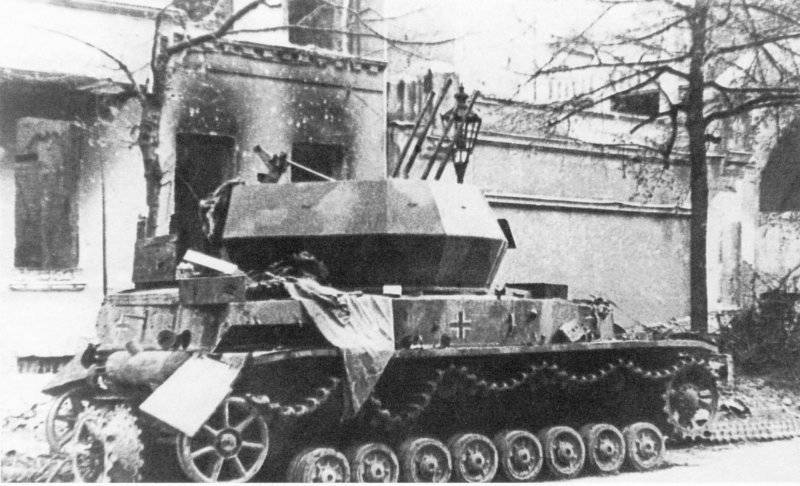
Anti-aircraft tank Flakpanzer IV "Wirbelwind" with a quad-mounted 20-mm guns Flak 38, shot down during the fighting on the street in Berlin May 1945 of the year (ASKM)
Rheinmetall, or more precisely, the company Vereinigte Apparatebau AG - this was the name of the design metal design office by this time - on October 23 1944 presented its project and model on the 1 scale: 10 to the tank weapon testing department. The discussion took place at a special meeting of the November 8 department.
The Flakpanzer V Zwilling 5,5 cm Gerat 58 was an Ausf Panther chassis. G with a rather massive turret mounted on it, in which two 55-mm Flak 58 guns were installed with an elevation angle from -5 to + 72 degrees (it was impossible to “raise” the gun anymore). In general, the project was approved by the military, but they proposed a number of changes to the design of the car. First of all, representatives of the company Rheinmetall had to consider the possibility of installing armor plates of the turret (especially the front) at high angles of inclination to the vertical. In addition, it was recommended to move the fans from the roof of the tower. One of them had to be installed under the mask of guns (for faster removal of powder gases when firing), and the second - in the lower part of the tower at the shoulder strap (to remove gases from the spent cartridges, which were poured down).
19 December 1944, representatives of Vereinigte Apparatebau, were again invited to the test section of tank weapons to further discuss the design of an anti-aircraft tank based on Panther. At this meeting, the military demanded that designers, in addition to two 55-mm cannons, install additional armament: an 20-mm MG 151 gun and an 7,92-mm MG 42 machine gun, two MG 42 and one MG 151 or two MG 151 guns. It was supposed to use this weapon as a sighting and to save 55 shots for the Flak 58 (the last unit of ammunition was slightly more than 100 units).
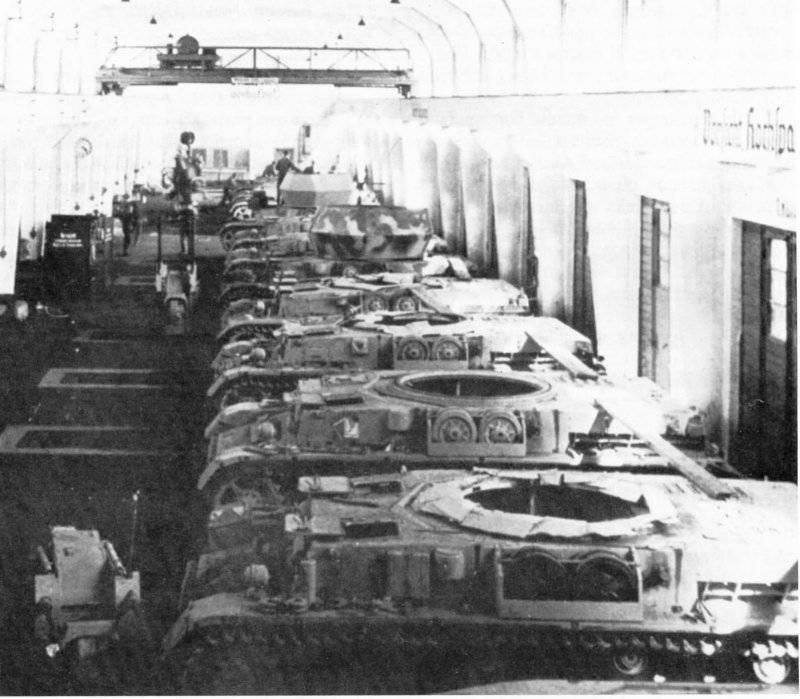
Workshop assembly Flakpanzer anti-aircraft tanks at the factory of the company Deutsche-Eisenwerke. 1944 year (NM)
To observe the battlefield, it was necessary to install an Ausf Panther turret on the roof. G. In addition, the issue of using an additional engine to rotate the turret and aiming guns at the target was discussed - due to the increased mass, the use of a drive from the tank engine proved ineffective. According to preliminary calculations, an additional motor with a capacity of about 42 l was required. with. and small sizes. The options for using the engines of the firms Hirth and Volkswagen were discussed, but they turned out to be rather weak for this, and besides, they were quite large and did not fit into the combat compartment of the tank. As a result, it was decided to abandon the use of an additional power plant and carry out the rotation of the tower as before - by taking power from the main engine of the tank.
After discussing their project and obtaining the necessary recommendations, Vereinigte Apparatebau AG (read -Rheinmetall) was to produce a full-scale wooden model of the tower, after the approval of which it was planned to build a prototype.
Almost simultaneously with the firm Vereinigte Apparatebau, the company Krzrr presented the project of its anti-aircraft tank on the Panther chassis. The Spark 55-mm anti-aircraft gun was mounted in the turret, which had armor thickness 15-40 mm. The elevation angles of the guns ranged from -5 to + 80 degrees, ammunition -104 shot. Four people stirred in the tower - the commander (he had at his disposal the commander's turret from the Panther Ausf. G), a gunner and two loaders. The Kshrr project did not have any particular advantages over the Vereinigte Apparatebau project, but after discussing it at the end of December 1944, the Krupp engineers received a go-ahead to refine their anti-aircraft tank and make a wooden tower layout.
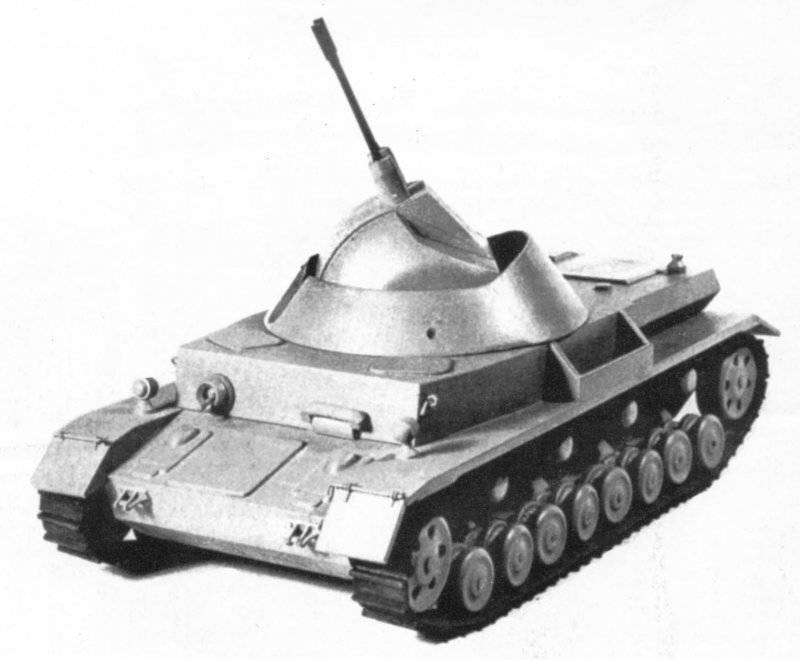
A wooden model of the Flakpanzer IV anti-aircraft tank with two 30-mm cannons in the Kugelblitz turret (Fireball)
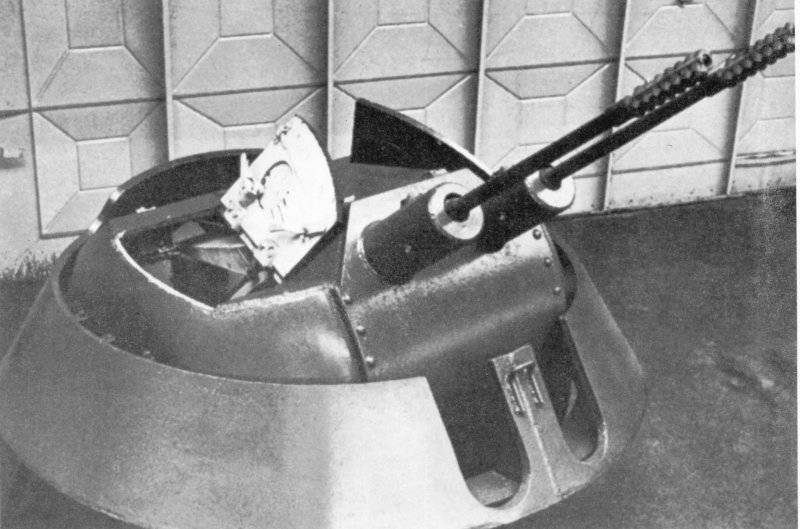
Top view of the ball lightning anti-aircraft installation with two 30-mm cannons Mk 103. Clearly visible 30-mm protective armor cover, as well as open hatches for loading ammunition (NM)
To speed up the readiness of the anti-aircraft tank on the Panther chassis, in November 1944, the tank armament testing department signed a contract with Duerkoppwerke for the manufacture of four Flak 55 X-mm guns - two each for the Kshrr and Vereinigte Apparatebau companies.
14 February 1945, a representative of the Tank Armaments Test Department (WaPruf 6) Colonel Kron told the company representatives that the development of an anti-aircraft tank with 55-mm guns on the Panther chassis is not a priority. However, Vereinigte Apparatebau was instructed to finish the manufacture of a wooden tower model. However, until the end of the war this work was not completed.
Anti-aircraft tank "Ball lightning" (Kugelblitz)
As early as the beginning of 1944, a proposal arose to use the 30 Mk 103 aircraft cannon for anti-aircraft 425 tanks. The gun had a fairly high rate of fire (rate of fire XNUMX rounds per minute) and powerful ammunition.
In the summer of 1944, engineer Josef von Glatter-Gotz, who worked in the automotive inspection department of the General Staff, designed a spherical turret for use on anti-aircraft tanks. After reviewing this proposal, the Tank Armaments Test Department (WaPruf 6) commissioned Daimler-Benz to finalize the design and fabricate a prototype installation.
14 July, 1944, the Armaments Directorate approved a plan to release the Fireball on the Pz chassis. IV starting from 5 September 1944. It was planned to reach the release of 30 machines per month by December. 5 September corrected these figures - Daimler-Benz was supposed to assemble the first two cars in October, and the Stahlindustrie plant three in November. Then the release should have increased, reaching in February 1945, the 100 machines per month.
However, the situation has made its own adjustments. The first prototype of the installation was manufactured at the Daimler-Benz Deutsche Eisenwerke plant in October 1944. “Ball lightning” was a spherical turret made of 20-mm armor, installed with a gimbal suspension in a fixed protective 30-mm armor casing in the form of a truncated cone. Initially, the tower was supposed to be installed on the tank Pz.IV.
The Spark 30-mm automatic guns of the 103 / 38 Mk were used as a fireball, which was a variant of an aircraft cannon, specially developed for installation in an anti-aircraft tank.
The total height of the “Ball Lightning” was 2300 mm, and the height of the tower was only 600 mm. Thus, the installation was quite compact. According to the initial design, the installation should have been rotated using mechanical drives and two flywheels, as on conventional anti-aircraft guns. But calculations have shown that the resulting speed is not sufficient to accompany attack aircraft. Therefore, the Aviation Research Institute in Berlin-Adlershof designed a hydraulic drive for rotating the turret. In this case, the rotation was carried out using a special joystick, similar to the steering wheel control fighter. As a result, now only one person was required for targeting the target. The speed of rotation of the ball lightning tower turned out to be very high - 45 degrees per second vertically, and 22 degrees per second horizontally. Ammunition was 1200 shots, laid in special boxes. Shelled sleeves and links of ribbons poured into special canvas bags. Each gun was equipped with a fan for removal of powder gases when firing.
The tower housed three people - the commander, he is the gunner, and two loaders. In this case, the crew was placed reclining, next to each other, which facilitated the transfer of commands. The use of a special periscopic sight and a stereoscopic rangefinder was intended as a means of guidance. In addition, for use on the "ball lightning" designed a special mechanical device to accompany the target. It was assumed that after the commander "captures" the enemy's aircraft with a sight and turns on the device, the latter will be able to "lead" the gun barrels for the air target.
However, the launch of the installation "Ball Lightning" was not possible. 30 January 1945 was approved a new production schedule for plants at the Stahlindustrie plant - by 10 in February and March, and 40 in April. The document “Review of the state of armament on tanks, assault, self-propelled guns and tractors up to August 1945 of the year”, dated by the end of February, on the “Thunderball” contains the following figures: 8 machines in March, 10 in April and starting from May - till 30 pieces per month (to August inclusive). It is indicated that the units should be mounted on the chassis Pz. Iv. In addition, there is such a note: "Whether or not a Fireball will be built at all has not yet been defined."
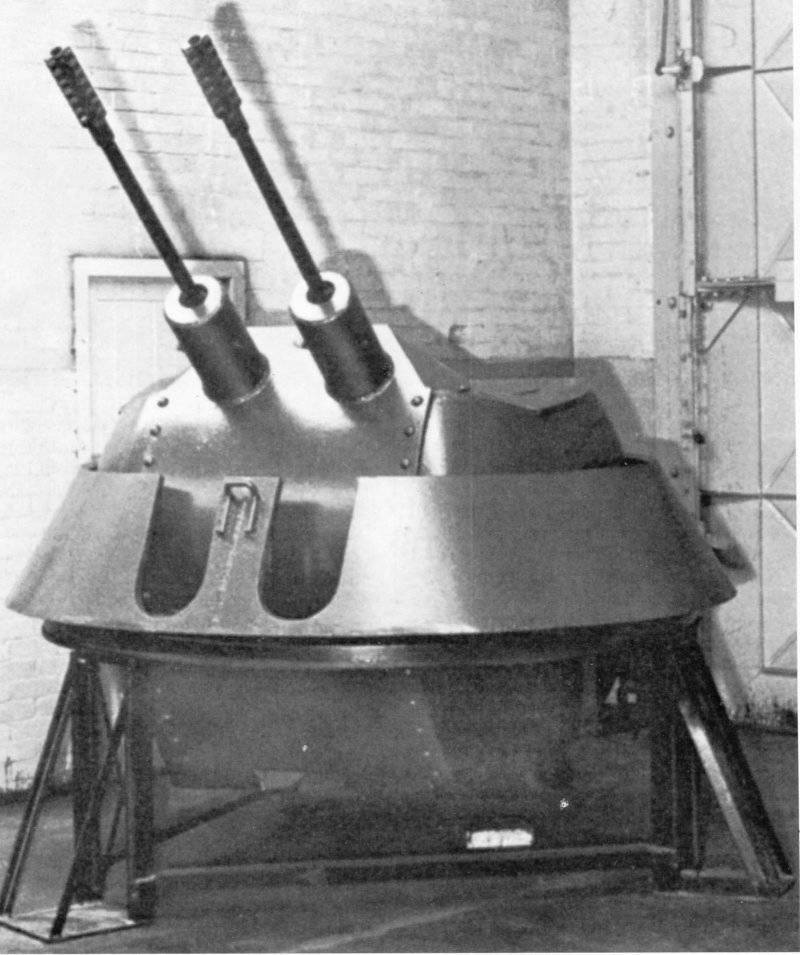
General view of the installation “Ball lightning with two 30-mm cannons Mk 103. Bottom visible armored box to accommodate the calculation (NM)
The fact is that despite the seemingly good characteristics, this installation had a number of drawbacks: it was very close, had a small ammunition and limited viewing angles of the commander. As for the use of the device to support the target, it was never manufactured, and its effectiveness seemed very doubtful. The opinion of engineer Zimmer is interesting (he worked at Rheinmetall and designed the tower for the Panther tank). Concerning "Ball Lightning" he stated that, in his opinion, only a non-professional engineer could develop such a tower.
However, several “Fireballs” were manufactured. Thus, the German researcher V. Spielberger writes about five manufactured machines assembled by Deutsche-Eisenwerke AG at the beginning of 1945 of the year and transferred to the training unit in Ordruf, Thuringia.
In the works of another authoritative researcher of German armored vehicles, T. Yen-tsa, other data are given. In one of his works, he cites interrogation data by the allies of representatives of the Daimler-Benz company. According to the testimony of engineer Ebel, only three fully finished "Fireballs" were manufactured by Deutsche-Eisenwerke. A representative from Deutsche-Eisenwerke, engineer Spalder, said that only two installation samples had been assembled and sent to Berlin.
However, there are other data. In one of the documents of the Reich ministry of armaments captured by Red Army units in 1945, there is information about the production of tanks and self-propelled guns for February 1945, by day. So, according to this document, the Stahlindustrie manufactured 7 “Ball Lightning” - 2 until February 10, February 2-13, February 2-19 and February 1-20. Although it is possible that in this document we are talking about the manufacture of installations (towers), and in the above data - about the assembly of machines in general.
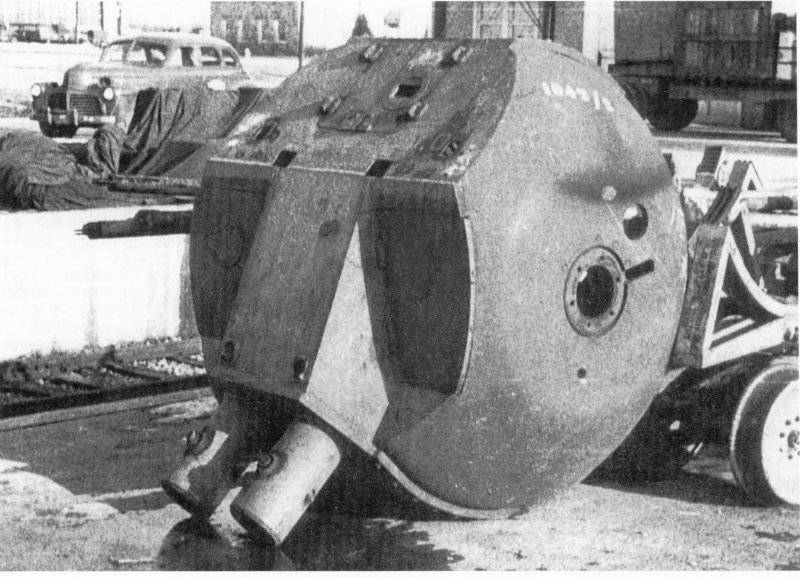
Ready armored tower installation "Fireball" at the factory of the company Deutsche-Eisenwerke. Spring 1945 of the year. In the board you can see the hole for mounting elements of the gimbal suspension (NM)
In addition to the chassis of the tank Pz. IV, the installation of "ball lightning" was planned on other tank chassis. 4 September 1944 of the year VMM has completed the project of installing such a tower on the basis of the Hetzer. In this case, the last side hull sheets installed vertically.
But after adopting the tank destroyer as the main chassis of the Jagdpanzer 38 D, a decision was made to install a Fireball on this base.
The release plan approved by 30 on January 1945 of the year was to produce the first 5 “Ball Lightning” on the Jagdpanzer 38 D in July 1945 of the year, 20 - in August, followed by an increase to 100 machines per month in December. However, the inspector general of tank troops 14 March 1945, at a meeting with the chief of the General Staff of the army, spoke out against the manufacture of "Ball lightning." In his opinion, first of all Jagdpanzer 38 D should be produced in the version of tank destroyer. As a result of the discussion, it was decided to use the Jagdpanzer 38 (t) repair to install the “Fireball”.
As a result, a plan to convert “Hetzer” into anti-aircraft tanks for 35-45 units per month. At the same time, since they were to be used together with the Jagdpanzer 38 D (8 anti-aircraft tanks for each battalion), their speed should have been the same. As a result, in addition to the installation of a ball lightning, it was also planned to mount a Tatra diesel engine during the repairs to the “Hetzer”. However, until the end of the war, the rework project was never completed.
At the same time as Ball Lightning, the company Vereinigte Apparatebau (design office of Rheinmetall) offered its own version of an anti-aircraft tank on the Jagdpanzer 38 D chassis. It was a Flak 37 X-gun mounted in a half-open tower. The project was reviewed by the Tank Armament Testing Department (WaPruf 44) 6 in January 13, and was generally approved. However, the military demanded to simplify the shape of the tower to facilitate production.
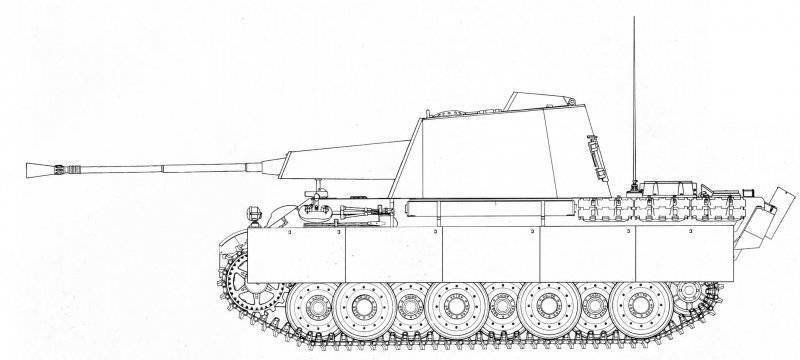
Flakpanzer V Zwilling 5,5 cm Gerat 58 anti-aircraft tank design with two 55-mm guns, developed by Vereinigte Apparatebau AG in the autumn of 1944 year
February 14 1945 firm Vereinigte Apparatebau announced that they have a draft simplified anti-aircraft tank based on the Jagdpanzer 38 D with minimal modifications of the latter. Armament - 37-mm gun Flak 44 - remained the same, and the rotation of the gun was carried out hydraulically with an additional automotive engine. The speed of the turns was 40 degrees per second. The gun was installed in the open top of the tower with armor thickness 16 mm. The crew of the tank was 4 man, ammunition transportable - 200 shots, mass 15 tons.
After receiving this information, representatives of WaPruf 6, said that because of the ambiguity with the release of Jagdpanzer 38 D, no decision on the manufacture of an anti-aircraft tank on this chassis now can not be accepted.
Thus, work on new anti-aircraft tanks did not come out of a series of projects and prototypes. And one could hardly have expected any new designs for these machines in the first half of 1945. Dealing with the flaws and testing of prototypes of the 55-mm anti-aircraft tank based on the Panther and Fireball on the Jagdpanzer 38 D took a long time. Yes, and it was hardly possible to select the right amount of chassis needed for the mass production of these machines. At best, the Jagdpanzer 38 D variant with the 37-mm cannon in an open turret could go with the series.
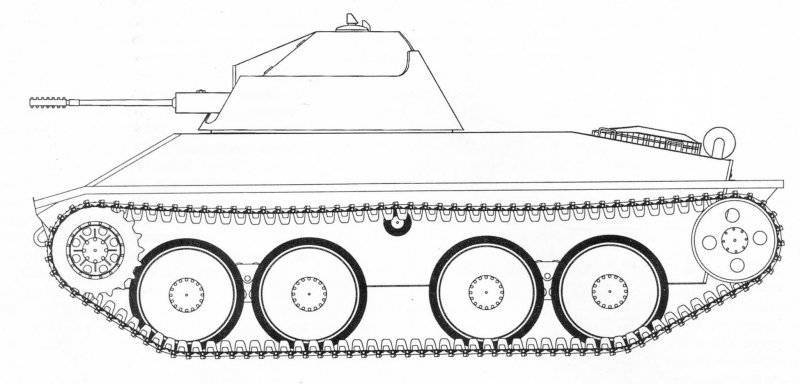
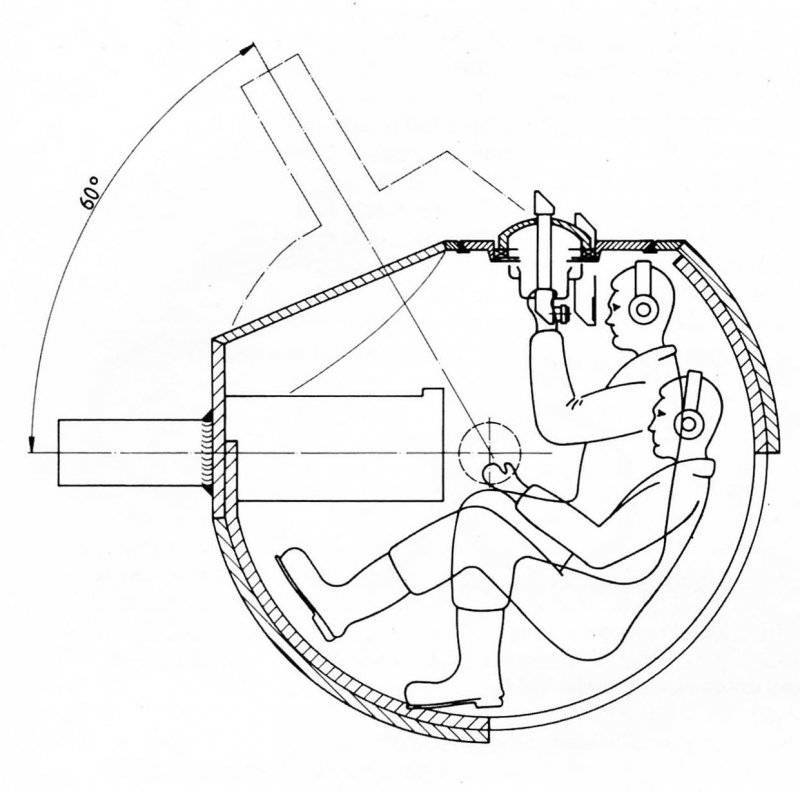
Information